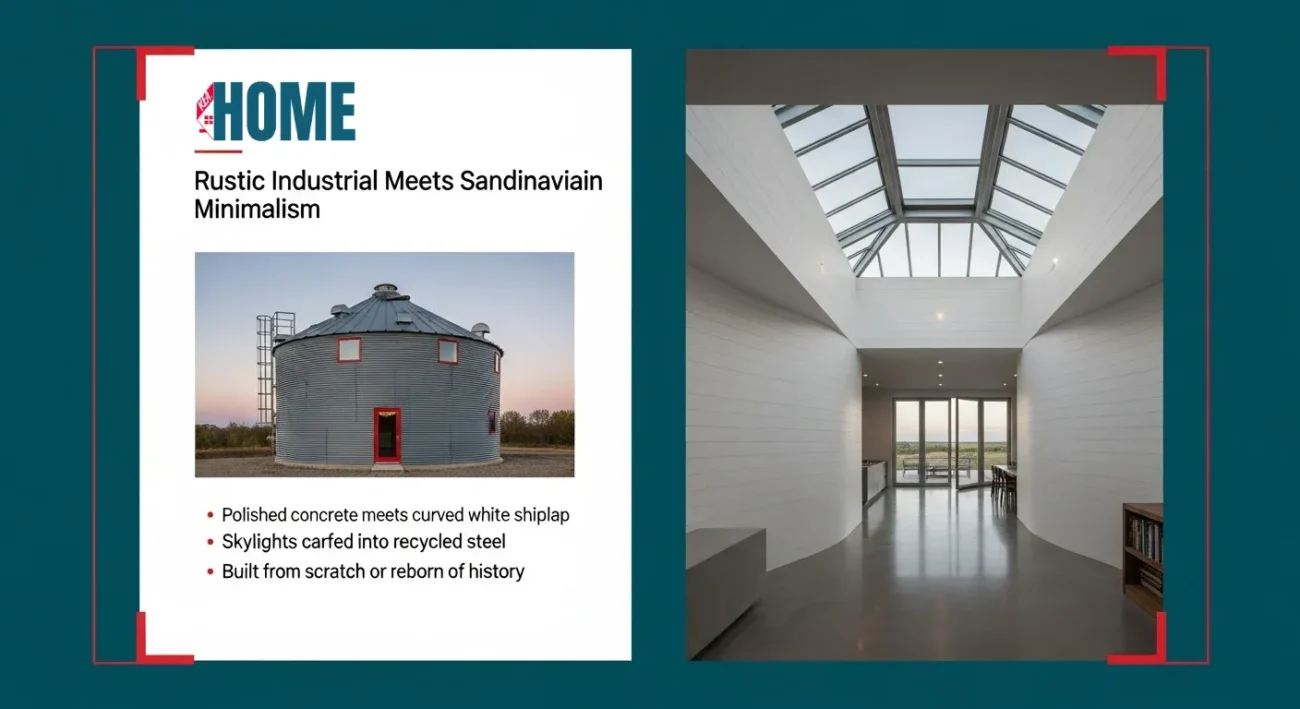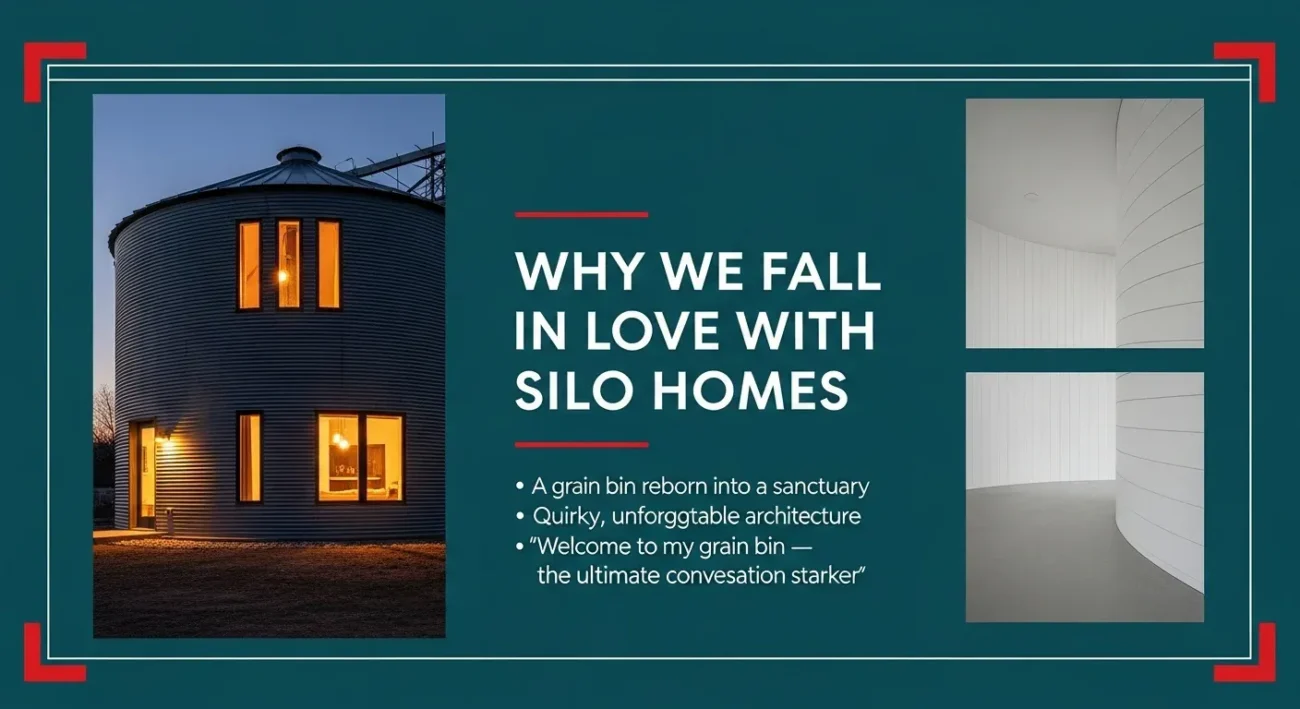
Home & Decor Blogs: DIY, Interior Design & Lifestyle Ideas
The Silo House | Modern Architecture Meets the Classic Grain Bin

A silo house is basically what happens when someone looks at an old grain bin on a farm and says, “Hey… that could be a cool house.” And surprisingly it works! These round metal silos, once used for storing corn or wheat, are now being converted into modern homes, tiny vacation rentals, and even luxury retreats.
The process usually involves setting the silo on a concrete foundation, adding thick insulation, cutting in windows and doors, and building cozy interior rooms inside the curved walls. Some even have spiral staircases, skylights, and multiple floors stacked like a tower.
The Silo House: A Hybrid of Rural History and Modern Design:
| Feature | (Humble Farm Grain Bin) | Modern Design (Genius Architect) |
|---|---|---|
| Origin | Humble farm grain bins | Creative vision of a genius architect |
| Form | Typically tall, cylindrical, and utilitarian | Reimagined to feel striking and modern |
| Construction | Basic agricultural structure | Innovative engineering and structural elements |
| Aesthetics | Rustic, metallic, and simple | Sleek, shiny, and sophisticated |
| Interior Space | Round, often with a tall, single room configuration | Customizable layouts to create distinct living zones |
| Design Possibilities | Unconverted, a simple storage solution | Integrated as a tower, linked with other structures, or forming a fully round house |
| Overall Vibe | Reminiscent of a bygone agricultural era | The “coolest home trend” with a blend of old and new |
What Exactly Is a Grain Bin & Why Use It as a House
Most people think of grain bins as boring silver cylinders sitting quietly on farms next to tractors. They’re usually made from corrugated galvanized steel and built to store literal tons of wheat, corn, or barley. Same durable, weather resistant structure makes them perfect for homebuilding.
Build a Home Out of a Circle Instead of a Rectangle
Living inside a geometric oddball comes with unexpected perks. For starters, circular buildings handle wind like superheroes. Hurricanes, Tornadoes, They just swirl right around the structure rather than blasting through flat walls. Energy efficiency also skyrockets because there’s less surface area to lose heat.
Rustic Industrial Meets Scandinavian Minimalism

The best silo homes don’t try to hide their agricultural past they embrace it. Imagine polished concrete floors, white shiplap walls curved gently around the room, and giant skylights carved into metal roofs. It’s like living in the perfect collision between a barn and an Apple Store.
Unfortunately, no. You can’t just drag a sofa inside and call it a day. Grain bins are empty shells, so they need foundations, insulation, framing, plumbing, and of course wooden doors unless you enjoy entering through a ladder hatch like a raccoon. Most builders either:
- Convert an existing farm silo, or
- Purchase a brand new grain bin kit and build from scratch.
Either way, expect customization. Round spaces force creativity, and that’s exactly the charm.
Silo House Cheaper Than a Traditional Home
It depends how fancy you get. A basic steel grain bin shell can cost as little as $20,000 to $50,000. But finishing the interior can bring the total to $120,000 $250,000, depending on layout, insulation, foundation, and level of luxury. Still, that’s often far cheaper than traditional builds plus the resale value is weirdly high thanks to uniqueness.
How Do You Fit a Kitchen into a Circle
Designing inside a round footprint is like playing Tetris blindfolded. You don’t get corners, so everything becomes an arc. Smart architects place kitchens and bathrooms along the perimeter and use the center for open plan living areas. Spiraling staircases are common in multi level silo homes because when life gives you spirals, you go full Bond villain.
What’s the Downside of Circular Living
I won’t sugarcoat it custom furniture is almost guaranteed. Also, insulation for a metal tube can be tricky, especially in hot climates. And if you’re the type who needs right angles to feel sane, this might not be your forever home. But if you’re adaptable and slightly whimsical, every quirk becomes part of the fun.
Recycling Architecture at Its Finest
Instead of consuming fresh concrete and lumber, grain bin homes repurpose existing industrial materials. Many eco builders love them because they reduce waste, minimize land disturbance, and can even be built off grid with solar panels wrapped around the exterior like shiny armor.
Why People Fall in Love with Silo Homes

- Poetic Transformation of History: There’s something undeniably poetic about converting a grain silo once used to store grain, the literal foundation of human civilization into a warm, personal living space. It honors agricultural history while innovatively flipping its original purpose into modern habitation.
- Unique and Memorable Appeal: Silo homes stand out for their quirky, eye catching design, turning everyday structures into one of a kind residences that spark curiosity and conversation.
- Conversation Starter: Telling guests “Welcome to my grain bin” is guaranteed to make you memorable, providing an instant icebreaker and a story that sets you apart from conventional homeowners.
FAQs
Can a silo house withstand extreme weather?
Yes! In fact, round metal structures perform better than traditional homes against high winds.
Do silo homes feel cramped?
Not if designed well. Many have soaring ceilings and central skylights that make them feel spacious.
Is it hard to get building permits for a silo house?
Depends on your local zoning laws. Some areas love innovation others panic at circles.
Can I build one myself?
If you’re handy, yes. But most people hire professional builders for insulation and foundation work.
Are they noisy in the rain?
Yes but in a romantic movie kind of way.
Final Thoughts
Silo homes prove that great design doesn’t have to start with a blank canvas sometimes it starts with an old grain bin and a big imagination. Whether you’re drawn to their sustainability, affordability, or simply their quirky charm, these circular spaces offer something traditional homes rarely do: personality. They’re not just places to live they’re conversation starters, creative projects, and a reminder that innovation can grow from the most unexpected places. If you’ve ever dreamed of living differently, a silo house might just be your roundabout way home.
